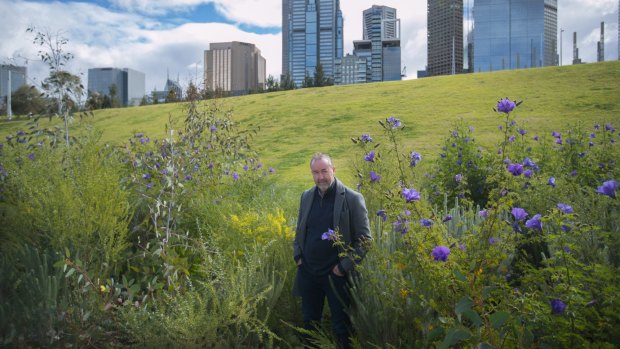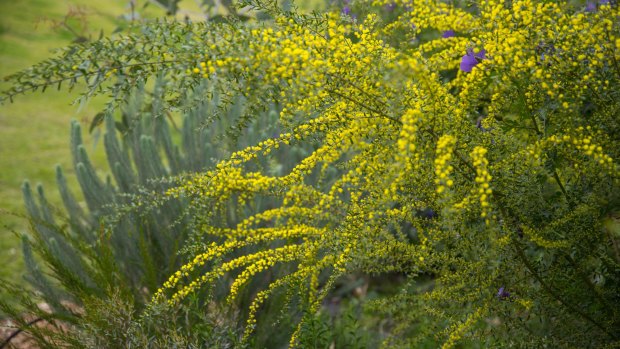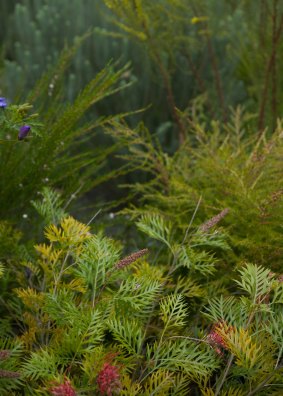This was published 5 years ago
World-first native 'meadow' a model alternative to the city's grassy fields
Two years on, these colourful expanses have exceeded expectations.
By Megan Backhouse
Planting in public places has always been a balancing act between creating visually interesting landscapes and fitting within stringent maintenance budgets. But what if you could come up with a planting scheme that was as layered and floriferous as the most beguiling wildflower meadow but as resilient and sustainable as a native grass monoculture?
Four years ago representatives from the universities of Melbourne and Sheffield and the City of Melbourne set out to do just that. They teamed up on a project to develop a meadow that was high on aesthetics, low on maintenance and composed entirely of robust Australian shrubs (Sheffield researchers are also exploring different planting mixes to suit a range of ecologies).

John Rayner in the trial meadow at Birrarung Marr.Credit: Simon Schluter
The aim was to develop a recipe for a playful, shrubby expanse that could be replicated across different sites.
Two trial meadows were planted – one at Birrarung Marr and the other at Royal Park – in September 2016. Each plot was covered with 200 millimetres of scoria and divided into 20 nine-square-metre sub-plots, some of which were planted more densely than others and some with more species.

The Birrarung Marr meadow has ''texture, colour and movement,'' says John Rayner.Credit: Simon Schluter
They were irrigated for only six months and at one point cut back – or coppiced – to 15 centimetres above the ground. These "woody meadows" have since been monitored by Melbourne University project leaders Claire Farrell and John Rayner, together with research assistant Leanne Hanrahan.
Rayner says the landscapes have "exceeded expectations" in terms of plant survival, growth, density and flowering. Anecdotally, they have also been popular, with passers-by saying they make a welcome change from some of the less diverse public plantings around town.
Importantly, their maintenance requirements fall within council regimes. Much of the work takes place well before planting – in the researching of what plants will thrive with the climate, soil, limited maintenance and regular coppicing.
The 21 species chosen (from an original list of 1200) provide long visual displays and a mix of heights ("base", "bump" and "emergent".)

A mix of Australian plants were grouped together as part of the project. Credit: Simon Schluter
Farrell and Rayner have regularly measured the heights of all plants, noted the species that were in flower, assessed the degree of canopy closure and kept a record of all that died or just failed to thrive. They found the plots that did best were those with high density (a spacing of 38 centimetres between plants) and low diversity (a mix of just 12 species).
Some plants did not perform as expected – the Banksia spinulosa subsp. spinulosa and Xanthosia rotundifolia have not been vigorous enough, both the Grevillea lanigera 'Mini Prostrate' and G. 'Coconut Ice' have been "hit and miss", while the "bump" layer's Acacia acinacea did so well it might be considered part of the higher "emergent" layer in future.
Farrell and Rayner plan to tweak their plant list and experiment with their coppicing regime – the first cut-back, in March 2017, was done with secateurs but next time a brush cutter will likely be used.
While some horticulturalists overseas – notably Cassian Schmidt in Germany – are also developing repeatable plant communities for different ecologies and regions, Rayner says coming up with a mix of shrubs that can be planted together is a world-first.
"This [woody meadow] has texture, colour and movement but it's also very functional. It could be a replacement for some of those low-diversity grassy plantings that are everywhere."
Rayner would also like to extend the project across new plots to experiment with different mixes that would work across other climates and soils and in new applications, such as in streets or under established trees.
Gardeners can also try it at home. There is signage at both sites, while details of the project are available at thegirg.org.